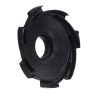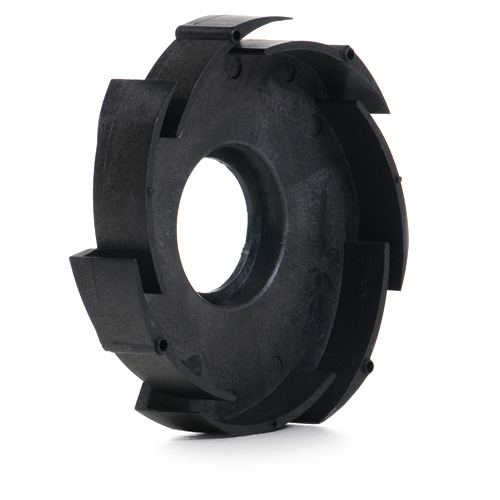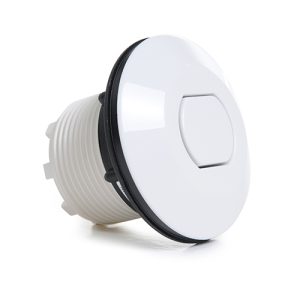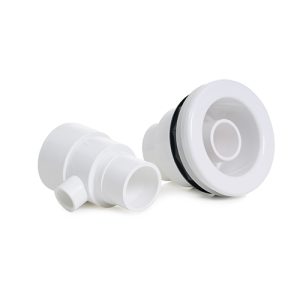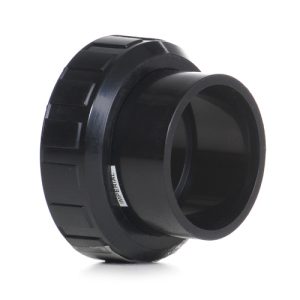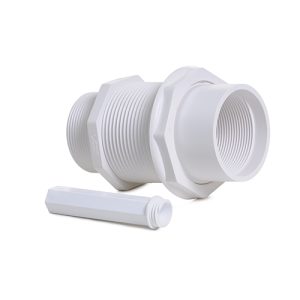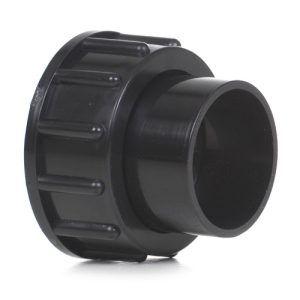Aquamite / Supastream Pump Diffuser
Critical Flow Control Component for Efficient Water Circulation
As a retailer of pool and spa parts, I stock this genuine replacement diffuser for Aquamite and Supastream pumps. The diffuser is a key hydraulic component that works in conjunction with the impeller to maximize pump efficiency and maintain optimal water flow throughout your pool or spa system.
What is a Pump Diffuser?
The diffuser is a stationary component that sits directly in front of the spinning impeller inside the pump housing. It features precisely engineered vanes or passages that guide water flow into the center of the impeller while directing discharged water toward the pump outlet. Think of it as the counterpart to the impeller—while the impeller spins to move water, the diffuser remains stationary to control and direct that flow.
Made from durable engineered plastic, the diffuser must withstand constant water flow, chemical exposure, and the hydraulic forces generated by the impeller spinning at over 3,000 revolutions per minute.
How the Diffuser Works
As the impeller spins, it throws water outward toward the edges through centrifugal force. The diffuser captures this high-velocity water and channels it efficiently toward the pump discharge port. Its specially designed passages gradually slow the water’s velocity while converting that kinetic energy into pressure—the pushing force that drives water through your filter, heater, and back to the pool.
The diffuser also creates a smooth flow path that directs incoming water from the suction side directly into the impeller eye (center). This optimized flow pattern reduces turbulence and cavitation, improving pump efficiency and reducing wear on components.
Additionally, the diffuser maintains the critical clearance gap between itself and the impeller. This small gap (typically 0.010 to 0.030 inches) is essential for proper operation—it prevents recirculation that would reduce efficiency while ensuring the impeller doesn’t contact the diffuser and cause damage.
Signs Your Diffuser Needs Replacement
Several symptoms indicate diffuser problems. Reduced water flow is most common—if your return jets are weaker than normal or filter pressure has dropped, a damaged diffuser may be the cause. Cracks or broken vanes in the diffuser disrupt flow patterns and reduce hydraulic efficiency.
Unusual noises like grinding, rattling, or excessive vibration can signal diffuser damage. If pieces have broken off the diffuser vanes, they may rattle around inside the pump or the remaining damaged structure may allow the impeller to contact the diffuser.
Air leaks at the diffuser seal allow air into the suction side of the pump, causing loss of prime. You might see bubbles in the pump basket or returning to the pool, or the pump may struggle to maintain water flow. Poor water circulation despite the pump running normally often points to hydraulic inefficiency from a damaged diffuser.
Common Causes of Diffuser Damage
Diffusers fail for several reasons. Chemical attack is significant—water that’s consistently outside the proper pH range (especially acidic conditions) degrades the plastic material over time. The constant exposure to chlorine, bromine, or other sanitizers also takes its toll, eventually making the plastic brittle.
Physical damage occurs when debris passes through the pump. Stones, sticks, or other hard objects can chip or crack the diffuser vanes. While the pump strainer basket should catch most debris, smaller items occasionally get through, especially if the basket isn’t cleaned regularly.
Running the pump dry generates extreme heat that can warp or melt the diffuser. Without water to cool components, temperatures inside the pump housing rise rapidly, damaging plastic parts. Age and UV exposure (if the pump sits in direct sunlight) also degrade the material over time.
Importance of the Diffuser in Pump Performance
The diffuser is essential to pump efficiency. A damaged diffuser can reduce flow by 20-50% even though the motor runs normally. This forces the pump to operate longer to achieve adequate circulation, wasting energy and increasing operating costs.
The diffuser also protects the impeller by maintaining proper clearance. Without the diffuser in place or with a damaged diffuser, the impeller may shift position or contact other components, causing rapid wear or catastrophic failure.
Proper hydraulic design in the diffuser minimizes turbulence and cavitation. Cavitation—the formation and collapse of vapor bubbles in the water—creates shock waves that erode pump components. A functioning diffuser reduces cavitation risk by maintaining smooth, controlled flow patterns.
Installation Considerations
Replacing the diffuser requires disassembling the pump to access the impeller area. The diffuser typically snaps or bolts into position in the pump housing, fitting between the impeller and the discharge port. It must be oriented correctly—most diffusers have a “TOP” marking that must align with the corresponding mark on the seal plate or housing.
The diffuser gasket (the rubber seal between the diffuser and housing) should be inspected and typically replaced during diffuser replacement. This gasket prevents water from bypassing the diffuser, which would reduce efficiency and potentially cause air leaks.
When reassembling, ensure the diffuser seats fully and evenly in its recess. Any gap or misalignment creates flow problems and may damage the new diffuser. The impeller clearance should also be checked after installing a new diffuser to ensure optimal spacing.
Compatibility
This diffuser is specifically designed for Aquamite and Supastream pump models. The vane design, dimensions, and mounting configuration are engineered to match these pumps’ hydraulic characteristics. Using the correct diffuser ensures optimal flow, proper clearances, and maximum efficiency.
These pumps are popular choices for residential pools and spas, making the diffuser a commonly needed replacement part during pump rebuilds or when addressing performance issues.
Product Specifications
| Specification | Details |
|---|---|
| Product Type | Pump Diffuser |
| Compatibility | Aquamite and Supastream pumps |
| Function | Directs water flow and converts velocity to pressure |
| Material | Engineered plastic (chemical and heat resistant) |
| Application | Stationary hydraulic component in pump wet end |
| Installation Location | Between impeller and pump discharge |
| Weight | 0.16 kg |
| Dimensions (L × W × H) | 0.1 m × 0.15 m × 0.15 m |
| Volume | 0.002 cubic meters |
| SKU | 6497240149 |
| Category | Pool & Spa Spares |
Preventive Maintenance
Protect your diffuser by maintaining proper water chemistry. Keep pH between 7.2 and 7.8 and sanitizer levels within recommended ranges. Extreme chemical conditions accelerate diffuser degradation.
Clean the pump strainer basket regularly—at least twice weekly during heavy use. This prevents debris from reaching the impeller and diffuser area where it can cause damage. Never run the pump without ensuring the system is properly primed with water.
Inspect the diffuser during routine pump maintenance or whenever the pump is opened for other repairs. Look for cracks, chips, or discoloration that indicates chemical damage. Catching deterioration early allows replacement before complete failure occurs.
This critical component works silently behind the scenes to ensure your pump operates at peak efficiency, delivering the water flow your pool or spa needs for proper filtration and circulation.
| Weight | 0.16 Kilograms |
|---|---|
| Length | 0.1 Meters |
| Width | 0.15 Meters |
| Height | 0.15 Meters |
| Volume | 0.002 CubicMeters |
| Supplier | GoldenC |
Related products
Spares
Spares

